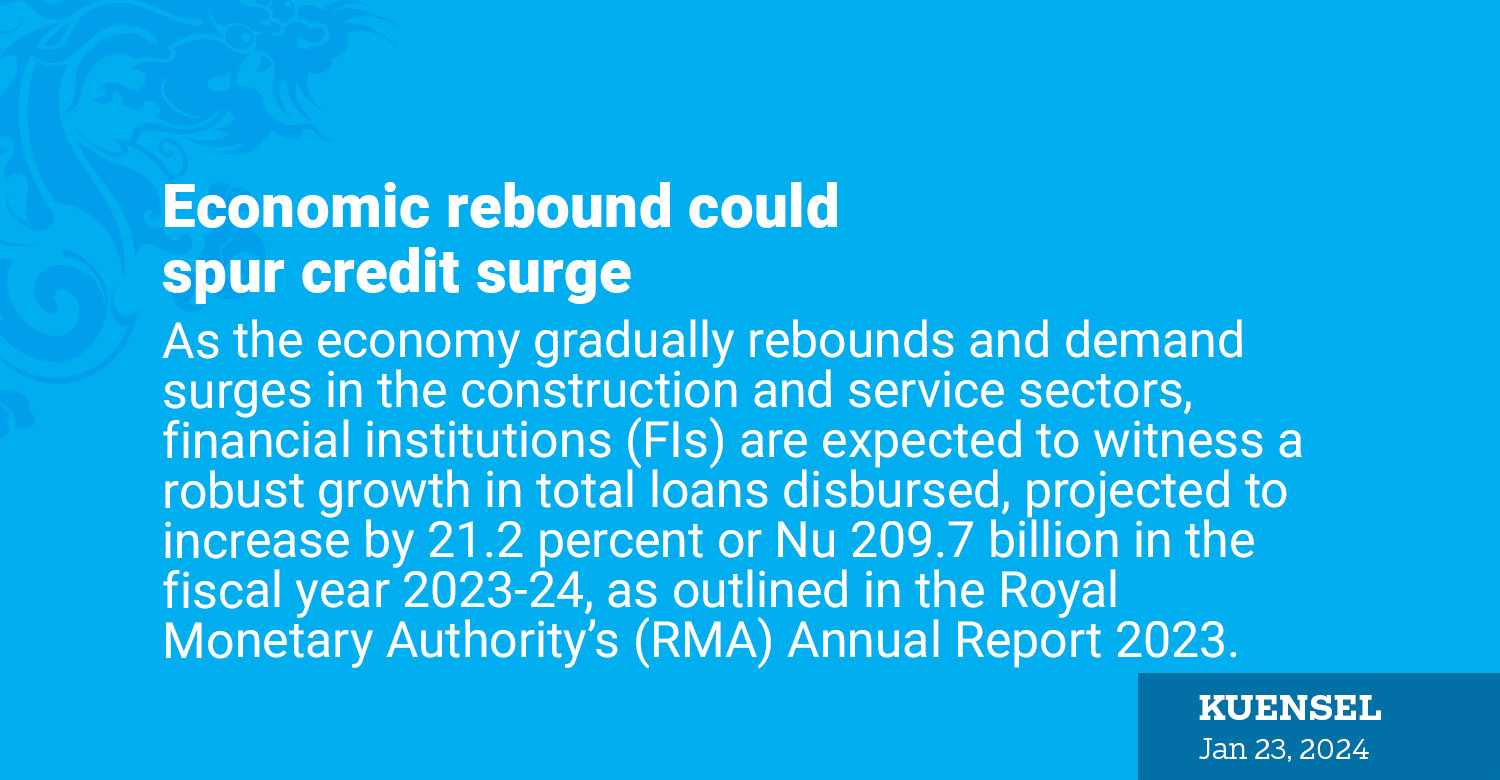… domestic credit expected to grow by 21.2 percent in FY 2023-24
Thukten Zangpo
As the economy gradually rebounds and demand surges in the construction and service sectors, financial institutions (FIs) are expected to witness a robust growth in total loans disbursed, projected to increase by 21.2 percent or Nu 209.7 billion in the fiscal year 2023-24, as outlined in the Royal Monetary Authority’s (RMA) Annual Report 2023.
The RMA states that this growth will be driven by heightened demand for investment in the hotel and tourism, trade and commerce, and overseas education loans.
However, the credit to the construction sector is anticipated to remain moderate due to the ongoing loan moratorium.
Credit growth is deemed beneficial for the economy, serving as an indicator of economic recovery. Increased credit allows consumers to borrow and spend more on housing, education, consumer durables, vehicles, and other personal expenses. Moreover, enterprises can secure more funds for investment.
However, the RMA issues a cautionary note regarding credit growth in unproductive sectors, as it has a direct correlation to higher imports, posing risks to foreign exchange reserves.
In the fiscal year 2022-23, credit growth exhibited a notable increase of 12.8 percent or Nu 23.79 billion. The total loans disbursed by banks and non-banks to customers reached Nu 205.8 billion, marking an 8 percent increase compared to the previous year.
The housing sector, constituting 27.9 percent of the total credit, experienced a substantial surge of 20.1 percent to Nu 58.45 billion. This increase was attributed to a rise in construction for commercial purposes and a softening of labor productivity.
However, the credit to the housing sector is anticipated to slow down in the fiscal year 2023-24 due to the loan moratorium imposed in June last year.
Similarly, credit to the transport sector saw a significant uptick of 19.6 percent or Nu 8.94 billion in FY 2022-23 compared to the previous fiscal year. Despite the extension of the moratorium on vehicle imports until February this year, the provision for importing utility cars contributed to the rise in loans to the transport sector.
In contrast, the credit to the service and tourism sector experienced a decline of 5.9 percent to Nu 45.08 billion, constituting 21.5 percent of the total credit. Within this sector, 56.4 percent of the loan share is attributed to the hotel and tourism sector, while the rest pertains to other services.
The production and manufacturing, as well as trade and commerce sectors, witnessed negative growth in fiscal year 2022-23. The trade and commerce sector’s loan dropped by 28.9 percent during this period, amounting to Nu 15.85 billion.
The credit to the agriculture sector remains below 5 percent of the total credit portfolio. In FY 2022-23, credit to the agriculture sector declined by 24.5 percent or Nu 1.55 billion, bringing the outstanding loan to Nu 4.78 billion from Nu 6.33 billion in the previous fiscal year.
This decline was mainly due to a fall in credit to crop cultivation and livestock farming, along with the credit moratorium imposed on Bhutan Development Bank Limited.
Commercial banks financed the majority, accounting for 82.8 percent (Nu 170.4 billion) of the total credits, with the remainder financed by non-banks. The credit-to-deposit ratio, measuring demand for credit relative to available funding, grew by 5.5 percent to 79.2 percent as of June last year.
The RMA estimates an increase in the bank’s credit to the private sector by 19.3 percent in the fiscal year 2022-23.
While the FIs’ non-performing loans saw a decline to Nu 7.76 billion in the fiscal year compared to Nu 16.06 billion in the previous fiscal year.


